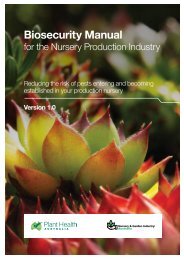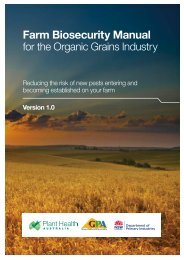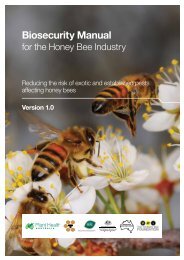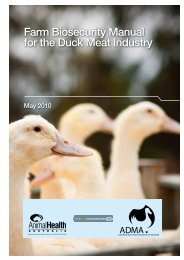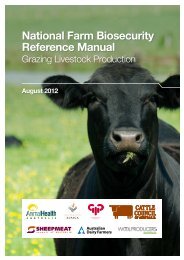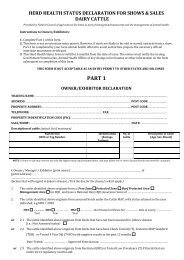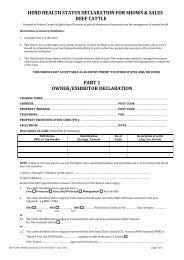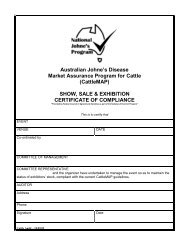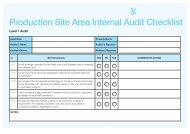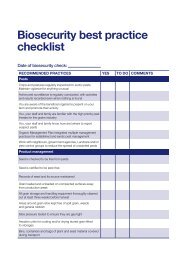Orchard Biosecurity Manual for the Mango Industry - Farm Biosecurity
Orchard Biosecurity Manual for the Mango Industry - Farm Biosecurity
Orchard Biosecurity Manual for the Mango Industry - Farm Biosecurity
Create successful ePaper yourself
Turn your PDF publications into a flip-book with our unique Google optimized e-Paper software.
16<br />
Equipment<br />
and vehicles<br />
Movement of vehicles and<br />
machinery<br />
Vehicles and orchard equipment, such<br />
as sprayers, tractors and hand tools, can<br />
carry pests in adhering soil, sap and plant<br />
material. Pests may <strong>the</strong>n be introduced to<br />
a previously clean property or crop.<br />
It is impractical to stop all vehicle and<br />
equipment movement on and off <strong>the</strong><br />
property, but using dedicated orchard<br />
vehicles, washing down machinery on<br />
concrete pads and denying access of<br />
dirty machinery can reduce <strong>the</strong> spread<br />
of pests.<br />
Contractors, re-sellers, service providers<br />
and drivers of delivery trucks (e.g. nursery<br />
stock, fertiliser, etc.) and earth moving<br />
equipment should be requested to<br />
clean <strong>the</strong>ir vehicles and equipment<br />
be<strong>for</strong>e entering your orchard. <strong>Orchard</strong>s<br />
open to <strong>the</strong> public and those open to<br />
growers (e.g. <strong>for</strong> field days, equipment<br />
demonstrations, etc.) have a heightened<br />
risk and <strong>the</strong>re<strong>for</strong>e designated parking<br />
areas away from production sites are<br />
important.<br />
Weedstop<br />
Weedstop<br />
Inspecting and cleaning machinery<br />
is more time and cost effective than<br />
managing a new pest introduced to<br />
your property<br />
Measures to reduce <strong>the</strong> risk of pest entry<br />
on equipment and vehicles include:<br />
• Cleaning vehicle floors and tyres of soil,<br />
plant material and pests, especially after<br />
visiting o<strong>the</strong>r properties.<br />
• Where possible, use your own vehicle to<br />
carry visitors around your orchard.<br />
• In production areas, keep vehicle<br />
movement to a minimum, especially<br />
on wet soil. Stick to regular pathways<br />
through <strong>the</strong> orchard.<br />
• Hose off and disinfect machinery in a<br />
designated wash-down area (see page<br />
17) be<strong>for</strong>e moving between properties.<br />
• Ensure contractor equipment is washed<br />
down thoroughly to remove any plant<br />
material or soil be<strong>for</strong>e entering your<br />
orchard.<br />
• Always make sure that borrowed and<br />
second-hand equipment and machinery<br />
is cleaned of all plant material and soil<br />
be<strong>for</strong>e moving <strong>the</strong>m into your orchard.<br />
• Regularly clean all tools and equipment,<br />
including pallets, pallecons, cherry<br />
pickers, boxes, bags, trimmers, ladders<br />
and any o<strong>the</strong>r equipment used in <strong>the</strong><br />
orchard, preferably with a disinfectant or<br />
bleach solution.



